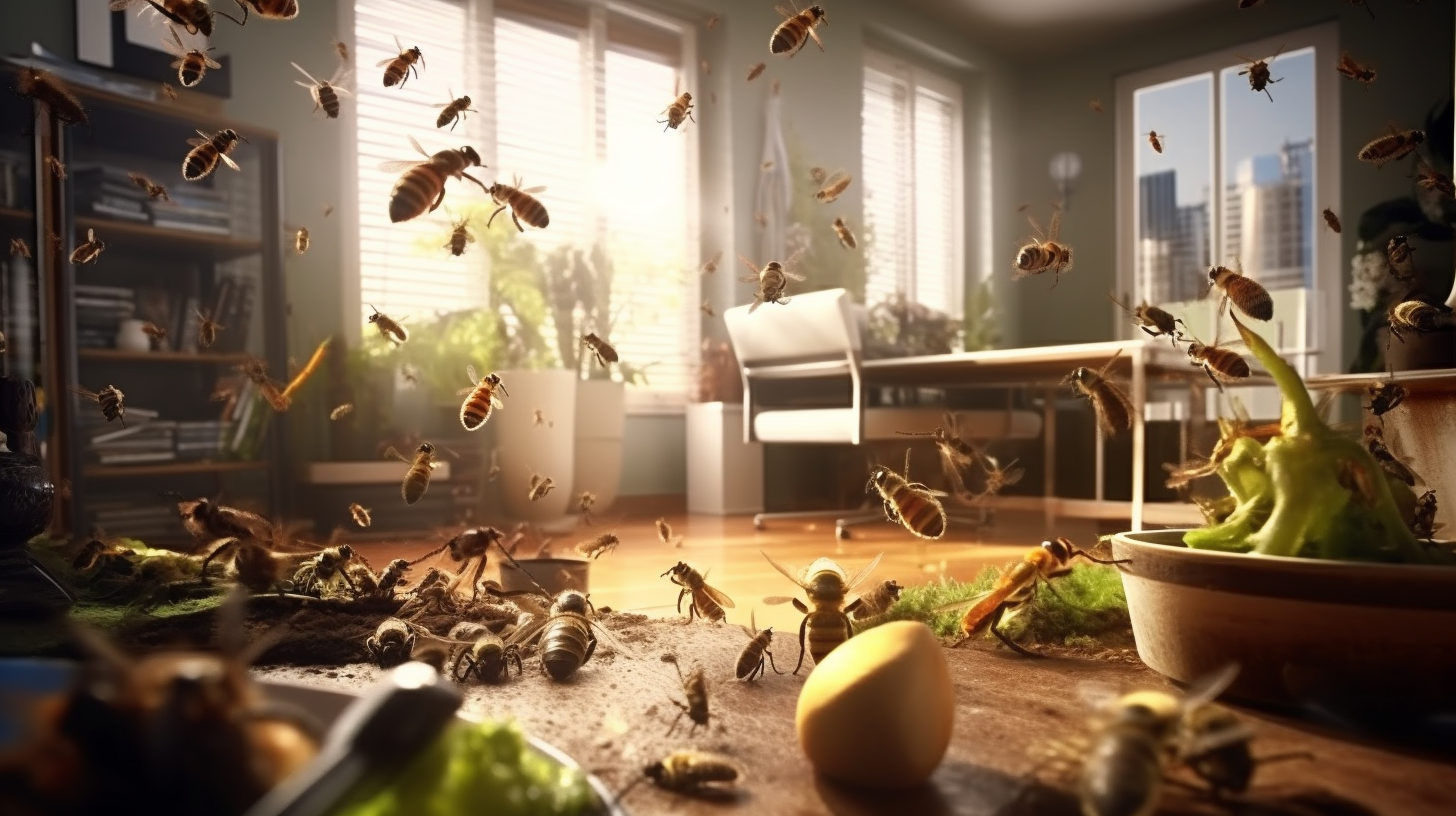
In an increasingly environmentally conscious world, traditional pest control methods are being reconsidered in favor of more sustainable options. Eco-friendly pest control is a growing practice that not only addresses common pest problems but does so in a way that minimizes harm to the environment, humans, and beneficial wildlife. This approach uses natural, non-toxic methods and integrated pest management (IPM) strategies, aiming to balance effective pest control with ecological preservation. By opting for eco-friendly solutions, homeowners and businesses can manage pests without contributing to chemical pollution or harming the delicate balance of local ecosystems. Whether it’s using natural repellents, introducing beneficial insects, or employing innovative techniques, eco-friendly pest control offers a safer and more responsible way to protect your home and the environment.
What is Eco-Friendly Pest Control?
Eco-friendly pest control refers to pest management methods that prioritize environmental sustainability while effectively managing unwanted pests. Instead of relying on synthetic chemicals and toxic substances, this approach utilizes natural, non-toxic alternatives to address infestations without causing harm to humans, pets, or the surrounding ecosystem.
Definition and Principles of Eco-Friendly Pest Control
Definition: What makes pest control “eco-friendly”?
Eco-friendly pest control involves using methods that minimize ecological disruption and avoid the use of harmful chemicals. This can include organic products, biological controls like introducing natural predators, and preventive measures that reduce the likelihood of infestations. The goal is to control pests while protecting the environment, ensuring that no lasting damage is done to soil, water, or other wildlife.
Principles of sustainability in pest management
At the core of eco-friendly pest control are principles of sustainability, which focus on long-term pest management solutions that prevent future infestations. These methods often include:
- Prevention over elimination: Reducing the factors that attract pests in the first place, such as proper waste management and sealing entry points.
- Biological controls: Using natural predators or parasites to control pest populations.
- Minimal chemical use: If chemicals are necessary, using the least toxic, biodegradable options that break down quickly without contaminating the environment.
Benefits of Eco-Friendly Pest Control
Health benefits: safer for humans and pets
One of the major advantages of eco-friendly pest control is its safety for people and pets. Traditional pest control methods often involve harsh chemicals that can pose health risks when inhaled or absorbed through the skin. In contrast, eco-friendly options use non-toxic ingredients, significantly reducing the risk of allergic reactions, respiratory issues, or other health problems for your family and pets.
Environmental advantages: less impact on soil, water, and biodiversity
Eco-friendly pest control methods are designed to have minimal impact on the environment. By avoiding the use of harmful pesticides, they prevent contamination of soil and water sources, preserving the local biodiversity. This helps protect beneficial insects, plants, and other wildlife from unintended harm, promoting a healthy ecosystem while controlling pests.
Long-term effectiveness: Reducing pests without harmful chemicals
In addition to being safer and more sustainable, eco-friendly pest control often provides more lasting solutions. Rather than relying on chemicals that pests may eventually become resistant to, sustainable pest management focuses on understanding pest behavior and using targeted methods that address the root cause of infestations. By improving sanitation, using natural repellents, and implementing preventive measures, eco-friendly pest control reduces the likelihood of future infestations, offering long-term effectiveness without the environmental cost.
Common Eco-Friendly Pest Control Methods
Eco-friendly pest control offers a variety of natural and sustainable solutions to effectively manage pests while minimizing harm to the environment. Below are some common methods that use biological, botanical, and physical strategies to reduce pest populations without relying on harmful chemicals.
Biological Pest Control
Biological pest control involves using natural predators and parasites to keep pest populations in check. By introducing beneficial insects or organisms into your garden or home, you can create a natural balance where pests are controlled without the need for synthetic pesticides.
Example: Introducing beneficial insects to reduce pest populations
One of the most popular examples of biological control is releasing ladybugs into your garden. Ladybugs feed on aphids, which are common garden pests. Similarly, nematodes, microscopic worms, are effective in controlling soil-dwelling pests like grubs and beetles. These natural predators can significantly reduce pest populations over time, creating a sustainable ecosystem that keeps pests under control without damaging the environment.
Botanical Pesticides
Botanical pesticides are plant-derived solutions that offer a natural alternative to synthetic chemicals. They are often biodegradable and break down quickly, making them a safer choice for both people and the environment.
Common plant-based solutions
- Neem oil: Extracted from the neem tree, this oil disrupts the life cycle of pests by interfering with their feeding and reproduction.
- Pyrethrum: Derived from chrysanthemum flowers, pyrethrum acts as a natural insecticide that targets a wide range of insects.
- Essential oils: Oils like peppermint, eucalyptus, and lavender can repel pests like ants, mosquitoes, and flies due to their strong scent.
How these pesticides work and their effectiveness
Neem oil works by interrupting the growth cycle of pests, making it particularly effective against insects like aphids, whiteflies, and spider mites. Pyrethrum, on the other hand, acts on the nervous system of insects, providing quick knockdown of pests like fleas and roaches. Essential oils work as repellents, driving pests away due to their strong odors. Although these botanical pesticides are effective, they are best used as part of an integrated pest management plan for long-term success.
Physical Barriers and Traps
Physical barriers and traps are non-toxic methods that physically prevent pests from accessing your home or garden, or capture them without using harmful chemicals.
Examples
- Mesh screens: Installing fine mesh screens over windows, doors, and vents can keep insects like mosquitoes and flies from entering your home.
- Sticky traps: These traps are coated with a sticky substance that captures crawling insects like ants or cockroaches as they move across surfaces.
- Diatomaceous earth: A natural powder made from fossilized algae, diatomaceous earth works by dehydrating and killing insects with exoskeletons, like ants, bed bugs, and fleas.
How to install and maintain these non-toxic solutions
To maintain the effectiveness of physical barriers, ensure that mesh screens are securely installed and free of holes. Sticky traps should be placed in high-traffic areas for pests and replaced regularly. Diatomaceous earth can be sprinkled in cracks and crevices or around the perimeter of your home and should be reapplied after heavy rains or cleaning.
Natural Repellents
Many household items can be repurposed as natural pest repellents. These common kitchen ingredients can deter pests without the use of harsh chemicals, making them safe for indoor use and around children and pets.
Using household items such as vinegar, garlic, or citrus as repellents
- Vinegar: A mixture of water and white vinegar can repel ants and fruit flies.
- Garlic: Garlic’s strong odor can deter pests like mosquitoes, slugs, and even rodents.
- Citrus: Citrus peels or sprays made from citrus oils are effective in repelling spiders, ants, and fleas.
Recipes and instructions for DIY repellents
- Vinegar Spray: Mix equal parts white vinegar and water in a spray bottle and apply to areas where you notice ant trails or fruit flies.
- Garlic Spray: Crush a few garlic cloves and steep them in water overnight. Strain the liquid and spray around doorways, windowsills, or plants to repel insects.
- Citrus Spray: Peel oranges, lemons, or limes and boil the peels in water. Once cooled, strain and pour the liquid into a spray bottle. Use around windows, doors, and garden plants to keep pests at bay.
Integrated Pest Management (IPM): A Holistic Approach
Integrated Pest Management (IPM) is an environmentally responsible strategy for controlling pests that emphasizes prevention, careful monitoring, and minimal use of chemical interventions. Unlike traditional pest control methods, which often rely on repeated pesticide applications, IPM takes a holistic approach by incorporating a variety of eco-friendly techniques. The goal of IPM is to manage pest populations in a way that reduces risks to human health and the environment.
What is Integrated Pest Management?
Definition of IPM and its principles
Integrated Pest Management (IPM) is a sustainable pest control approach that focuses on long-term prevention and uses a combination of techniques to manage pests. At its core, IPM seeks to minimize the use of harmful chemicals and emphasizes natural and mechanical methods to control pest populations. The key principles of IPM include:
- Prevention: Taking proactive steps to reduce the likelihood of infestations.
- Monitoring: Regularly inspecting and tracking pest activity.
- Minimal chemical use: Chemicals are only used as a last resort and are chosen based on their minimal environmental impact.
- Eco-friendly control methods: When pest problems arise, solutions like biological controls and physical barriers are prioritized.
This approach allows for effective pest management while protecting the environment and promoting healthy ecosystems.
Four Key Steps in IPM
Integrated Pest Management involves four key steps: prevention, monitoring, control, and evaluation. These steps work together to provide a comprehensive and adaptable approach to pest control.
Prevention
Prevention is the cornerstone of IPM. By taking proactive measures to avoid pest problems, you can reduce the need for reactive treatments like pesticides. Prevention techniques focus on eliminating the factors that attract pests and providing physical barriers to entry.
Sealing entry points: One of the most effective ways to prevent pests is by sealing potential entry points such as windows, doors, and cracks in walls or foundations. Installing door sweeps, weatherstripping, and mesh screens can prevent insects and rodents from entering your home.
Keeping a clean and uncluttered environment: Regular cleaning, proper food storage, and minimizing clutter can reduce hiding spots and food sources for pests like cockroaches, ants, and mice.
By focusing on these preventative measures, you create an inhospitable environment for pests, making infestations far less likely.
Monitoring
Monitoring is a critical aspect of IPM that involves regular inspections to detect pests early and assess their population levels. By keeping track of pest activity, you can intervene before a minor issue becomes a major infestation.
Regular inspection of your home for early detection of pests: Check common pest hotspots such as kitchens, bathrooms, basements, and attics. Look for signs of pest activity like droppings, damaged food packaging, or insect wings.
Tools and techniques for effective pest monitoring: Sticky traps, pheromone traps, and visual inspections can help you detect pests before they become a serious problem. For larger properties, keeping a detailed record of pest sightings and activity can guide future control efforts.
Consistent monitoring ensures that any issues are caught early, allowing for eco-friendly control methods to be used at the right time.
Control
When pests are found, IPM emphasizes using the least invasive, most eco-friendly control methods. By targeting pests with precision, you can manage infestations without harming beneficial organisms or the environment.
Using eco-friendly solutions when pests are found: Once pests are detected, solutions like biological controls (introducing natural predators), botanical pesticides, or physical barriers are applied.
Example: For instance, if aphids are found in your garden, releasing ladybugs can naturally reduce the aphid population without resorting to synthetic chemicals. Similarly, placing diatomaceous earth in areas where ants are active provides a safe, non-toxic control method.
This step ensures that pests are managed in a way that minimizes harm to humans, pets, and the environment.
Evaluation
Evaluation is the final step in the IPM process. After implementing control measures, it is important to assess their effectiveness and adjust your strategy as needed.
Assessing the effectiveness of the solution: Review the outcome of your pest control efforts by monitoring pest activity after treatment. If pest populations are reduced or eliminated, the methods used were likely successful.
Adjusting the strategy based on results: If pests persist, consider modifying your approach by increasing the frequency of monitoring, trying different eco-friendly methods, or addressing previously overlooked entry points.
Ongoing evaluation allows you to fine-tune your pest management strategy, ensuring long-term success and minimizing the need for harmful interventions.
DIY vs. Professional Eco-Friendly Pest Control
When it comes to eco-friendly pest control, both DIY methods and professional services have their place. Deciding which route to take depends on the severity of the infestation, the type of pests involved, and your personal comfort with handling pest control tasks. In this section, we’ll explore when it’s appropriate to use DIY pest control and when it’s best to call in the professionals.
When to Use DIY Pest Control
DIY eco-friendly pest control is a great option for smaller infestations and common household pests that can be managed with minimal intervention. With the right knowledge and tools, homeowners can often address issues before they become major problems.
Small-scale infestations and simple household pests
For minor infestations—such as a few ants, fruit flies, or the occasional spider—DIY pest control is typically effective and budget-friendly. Common household pests like these can often be managed using natural, eco-friendly methods without the need for professional intervention. These pests are typically easy to locate, and their numbers can be controlled using simple techniques like sealing entry points, removing food sources, and applying natural repellents.
Examples of pests suitable for DIY control: Ants, flies, cockroaches, moths, and spiders.
Recommended products for DIY enthusiasts
There are many eco-friendly products available for DIY pest control that allow you to tackle infestations while protecting the environment. These products are typically plant-based, non-toxic, and safe to use around children and pets.
Neem oil: Effective for garden pests like aphids, mites, and whiteflies.
Diatomaceous earth: A non-toxic powder that can be used indoors and outdoors to control ants, bed bugs, and other crawling insects.
Essential oil sprays: Peppermint, lavender, and eucalyptus oils can repel pests like ants, spiders, and mosquitoes when diluted and sprayed around the home.
Using DIY methods for small infestations gives you the flexibility to manage pests at your own pace while keeping your home chemical-free. However, it’s important to monitor the situation closely—if the infestation grows or becomes difficult to control, it may be time to consider professional help.
When to Hire Professional Eco-Friendly Pest Control Services
For larger infestations or more complex pest problems, professional eco-friendly pest control services offer the expertise and resources necessary to handle the issue effectively. Professionals are trained to assess the extent of an infestation, identify pest species, and implement targeted, non-toxic solutions.
Larger infestations that require expertise
If pests have spread throughout your home or yard, or if you’re dealing with more difficult-to-manage pests like termites, rodents, or bed bugs, hiring a professional service is often the most efficient and effective solution. Large infestations can quickly overwhelm DIY efforts and may require specialized equipment and knowledge to fully eradicate.
Professional pest control technicians are equipped to handle:
Structural pests like termites, which can cause significant damage to your home.
Widespread infestations of pests such as rodents, which can be difficult to control with DIY methods alone.
Recurring problems that persist despite repeated DIY efforts.
What to look for in a professional service
When selecting an eco-friendly pest control service, it’s important to ensure that the company aligns with your values of sustainability and safety. Look for services that are certified, use non-toxic methods, and have a strong reputation for delivering environmentally responsible pest control solutions.
Certification: Choose companies certified by recognized pest control associations or regulatory bodies that ensure adherence to eco-friendly standards.
Non-toxic methods: Verify that the company uses organic, plant-based, or biological controls rather than harmful chemicals.
Client reviews: Check for positive feedback from previous customers, especially those who prioritize eco-friendly practices. Reviews can provide insight into the company’s reliability, customer service, and effectiveness.
By hiring a professional service that specializes in eco-friendly pest control, you can rest assured that your pest problem will be handled efficiently and sustainably, with minimal impact on the environment and your health.
Preventing Future Pest Infestations Naturally
Taking proactive measures to prevent pests from entering your home is key to maintaining a healthy, eco-friendly living environment. By using natural methods to keep pests at bay, you can reduce the need for chemical treatments while protecting your home and the environment. Here are some effective strategies for making your home naturally pest-resistant.
Maintaining a Pest-Resistant Home
To prevent pest infestations, it’s important to maintain a clean, organized, and well-sealed home. Pests are often attracted to food, clutter, and moisture, so addressing these areas is essential for long-term prevention.
Cleanliness and Organization
A clean, clutter-free home is less attractive to pests like ants, cockroaches, and rodents. By paying special attention to food storage and waste management, you can eliminate some of the most common factors that attract pests into your living spaces.
Keeping food storage areas clean: Regularly clean your kitchen counters, pantries, and cupboards to remove food crumbs and spills. Store dry goods like cereals, grains, and snacks in airtight containers to prevent pests like ants and weevils from gaining access. Vacuuming and wiping down surfaces often will help reduce the risk of infestation.
Proper waste management: Dispose of food scraps and organic waste in sealed garbage bins and empty them regularly to avoid attracting pests. Compost bins should be properly maintained and covered, and outdoor trash bins should be kept away from the house to reduce the likelihood of attracting rodents and insects.
By maintaining a high level of cleanliness and organization, you create an environment that is inhospitable to pests, making infestations far less likely.
Natural Barriers
Plants can be a great way to naturally repel pests from your home and garden. Many plants emit scents that pests find unpleasant, and incorporating these into your landscaping or indoor decor can help deter unwanted visitors.
Using plants like basil, lavender, or marigold to repel pests:
- Basil: This aromatic herb is known to repel flies and mosquitoes. Plant basil near windows and doorways, or place potted basil plants indoors to keep pests away.
- Lavender: Not only does lavender add a pleasant fragrance to your home, but its scent is also known to repel moths, fleas, and flies. Lavender sachets can be placed in closets and drawers to keep these pests at bay.
- Marigolds: These bright flowers repel a variety of pests, including aphids, mosquitoes, and even rabbits. Plant marigolds around the perimeter of your home or garden to create a natural pest barrier.
Using natural barriers like these plants helps create a pest-resistant environment while adding beauty and fragrance to your home.
Proper Home Maintenance
Regular home maintenance is essential for preventing pests from finding ways to enter your home. Pests often take advantage of cracks, gaps, and other structural weaknesses, so it’s important to inspect and maintain your home regularly.
Regularly inspecting your home for cracks or leaks: Small cracks in walls, windows, or foundations can provide entry points for pests like ants, spiders, and rodents. Regularly inspect your home’s exterior for gaps or damage, and seal any cracks with caulk or weather-stripping to block pests from entering.
Ensuring proper ventilation and moisture control: Many pests, such as termites and cockroaches, are attracted to moisture. Make sure your home is well-ventilated, especially in areas prone to dampness like basements, attics, and bathrooms. Fix any leaks promptly and use dehumidifiers in areas with excess moisture to discourage pests from settling in.
By keeping your home in good repair and addressing potential entry points, you can prevent pests from gaining access and reduce the need for more aggressive pest control measures.
FAQs
Contact Bull City Crawlspace Today!
Bull City Crawlspace will do everything we can to ensure your experience with us is excellent.
Request A FREE Estimate
Request a Free Estimate Form
Checkout Recent Post




Got a Question? We’re Here to Help.
You can arrange an appointment or make an enquiry by phone or email, orget in touch to us via our contact form.

